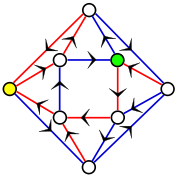
Synchronizing word
Encyclopedia

Computer science
Computer science or computing science is the study of the theoretical foundations of information and computation and of practical techniques for their implementation and application in computer systems...
, more precisely, in the theory of deterministic finite automata (DFA), a synchronizing word or reset sequence is a word in the input alphabet of the DFA which sends any state of the DFA to one and the same state. That is, if an ensemble of copies of the DFA are each started in different states, and all of the copies process the synchronizing word at the same speed, they will all end up reaching the same state as each other, at the same time as each other. Not every DFA has a synchronizing word; for instance, a DFA with two states, one for words of even length and one for words of odd length, can never be synchronized.
The problem of estimating the length of synchronizing words has a long history and was posed independently by several authors, but it is commonly known as the Černý conjecture. In 1964 Jan Černý conjectured that (n − 1)2 is the upper bound
Upper bound
In mathematics, especially in order theory, an upper bound of a subset S of some partially ordered set is an element of P which is greater than or equal to every element of S. The term lower bound is defined dually as an element of P which is lesser than or equal to every element of S...
for the length of the shortest synchronizing word for any n-state complete DFA (a DFA with complete state transition graph). If this is true, it would be tight: in his 1964 paper, Černý exhibited a class of automata (indexed by the number n of states) for which the shortest reset words have this length. The best upper bound known is n(7n2+6n-16)/48, far from the lower bound. .
For n-state DFAs over a k-letter input alphabet, an algorithm by David Eppstein
David Eppstein
David Arthur Eppstein is an American computer scientist and mathematician. He is professor of computer science at University of California, Irvine. He is known for his work in computational geometry, graph algorithms, and recreational mathematics.-Biography:Born in England of New Zealander...
finds a synchronizing word of length at most 11n3/48 + O
Big O notation
In mathematics, big O notation is used to describe the limiting behavior of a function when the argument tends towards a particular value or infinity, usually in terms of simpler functions. It is a member of a larger family of notations that is called Landau notation, Bachmann-Landau notation, or...
(n2), and runs in time complexity
Time complexity
In computer science, the time complexity of an algorithm quantifies the amount of time taken by an algorithm to run as a function of the size of the input to the problem. The time complexity of an algorithm is commonly expressed using big O notation, which suppresses multiplicative constants and...
O
Big O notation
In mathematics, big O notation is used to describe the limiting behavior of a function when the argument tends towards a particular value or infinity, usually in terms of simpler functions. It is a member of a larger family of notations that is called Landau notation, Bachmann-Landau notation, or...
(n3+kn2). This algorithm does not always find the shortest possible synchronizing word for a given automaton; as Eppstein also shows, the problem of finding the shortest synchronizing word is NP-complete
NP-complete
In computational complexity theory, the complexity class NP-complete is a class of decision problems. A decision problem L is NP-complete if it is in the set of NP problems so that any given solution to the decision problem can be verified in polynomial time, and also in the set of NP-hard...
. However, for a special class of automata in which all state transitions preserve the cyclic order of the states, he describes a different algorithm with time O(kn2) that always finds the shortest synchronizing word, proves that these automata always have a synchronizing word of length at most (n − 1)2 (the bound given in Černý's conjecture), and exhibits examples of automata with this special form whose shortest synchronizing word has length exactly (n − 1)2.
The road coloring problem is the problem of labeling the edges of a regular
Regular graph
In graph theory, a regular graph is a graph where each vertex has the same number of neighbors; i.e. every vertex has the same degree or valency. A regular directed graph must also satisfy the stronger condition that the indegree and outdegree of each vertex are equal to each other...
directed graph
Directed graph
A directed graph or digraph is a pair G= of:* a set V, whose elements are called vertices or nodes,...
with the symbols of a k-letter input alphabet (where k is the outdegree
Degree (graph theory)
In graph theory, the degree of a vertex of a graph is the number of edges incident to the vertex, with loops counted twice. The degree of a vertex v is denoted \deg. The maximum degree of a graph G, denoted by Δ, and the minimum degree of a graph, denoted by δ, are the maximum and minimum degree...
of each vertex) in order to form a synchronizable DFA. It was conjectured in 1970 by Benjamin Weiss and Roy Adler that any strongly connected and aperiodic regular digraph can be labeled in this way; their conjecture was proven in 2007 by Avraham Trahtman
Avraham Trahtman
Avraham Trahtman is a mathematician at Bar-Ilan University . In 2007, Trahtman solved a problem in combinatorics that had been open for 37 years, the Road Coloring Conjecture posed in 1970.-Road coloring problem posed and solved:...
.

